chapter9-搜索
搜索是一种有目的地枚举问题的解空间中部分或全部情况,进而找到解的方法。它的定义是:
起始状态经过一系列的状态转移抵达目标状态,我们一般用搜索树(Search Tree)来表示状态转移
搜索一般包括4个部分:
-
1、状态空间,也叫解空间;
-
2、状态转移;
-
3、起始状态;
-
4、目标状态。
如何构思上面的四个部分呢,比如状态空间是什么,举个例子:
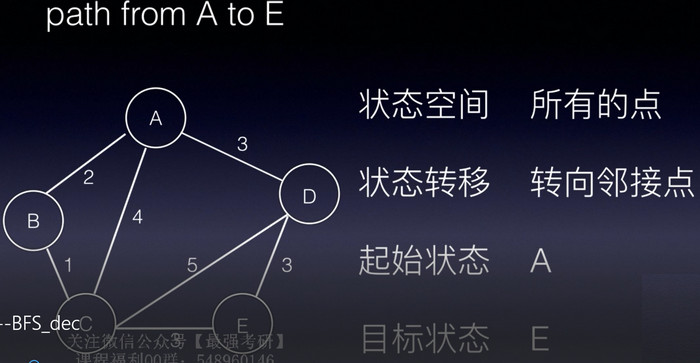
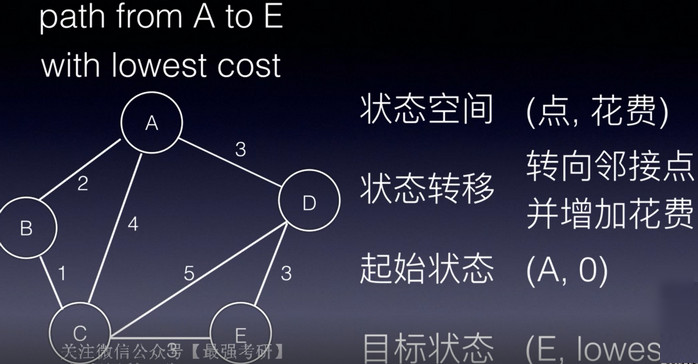
1.Search Trees
以寻找从点A到点E的路径问题为例,建立一颗搜索树,建好搜索树之后,还需要确定搜索策略,即先扩展树中的哪个结点,搜索策略有宽度优先搜索、深度优先搜索两种。
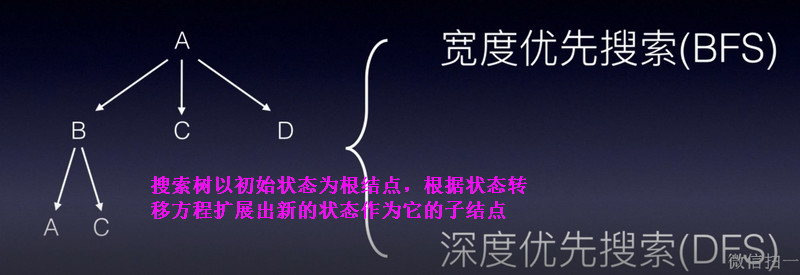
2.BFS
策略:每次优先处理当前所有未处理状态中深度最浅的一个状态,即处理最浅的结点。
采用这样的搜索策略,可以发现是一层一层从左到右的扩展,也就是先扩展的先处理,符合队列先进先出特性。
2.1 Catch That Cow
题目描述:
Farmer John has been. informed of the location of a fugitive cow and wants to catch her immediately.He starts at a point N(0≤N≤100000) on a number line and the cow is at a point K (0≤K≤100000)on the same number line. Farmer John has two modes of transportation: walking and teleporting.
Walking:Farmer John can move from any point X to the pointsX- 1 orX+ 1 in a single minute.Teleporting: Farmer John can move from any point xto the point 2X in a single minute.
输入:
Line 1: Two space-separated integers: N and K.
输出:
Line 1: The least amount of time, in minutes, it takes for Farmer John to catch the fugitive cow.
搜索类题目,首先写出搜索问题的4个部分:
-
1、状态空间 (位置n, 时间t)
-
2、状态转移 (n-1, t+1), (n+1, t+1), (2n, t+1),共3种移动方式
-
3、起始状态 (N, 0)
-
4、目标状态 (K, lowestTime)
然后建立一颗搜索树:
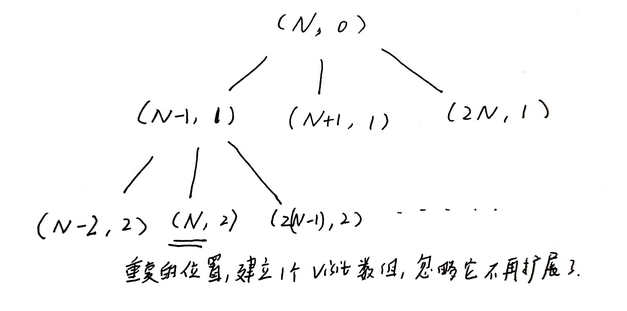
确定搜索策略:抓到牛并且花费时间最少,BFS逐层搜索符合题目要求。同时注意到,对重复位置的状态,为了提高搜索的效率,设置visit数组,不再对它进行扩展。
抓住那只牛
//2024-03-08 搜索 Catch that cow
#include <iostream>
#include <cstdio>
#include <queue>
using namespace std;
const int MAXN = 1e5 + 10;
bool visit[MAXN];
struct Status {
int position;
int time;
Status(){}
Status(int p, int t): position(p), time(t) {}
};
int BFS(int n, int k) {
queue<Status> myQueue;
myQueue.push(Status(n, 0));//把搜索树的根结点压入队列
visit[n] = true;
while(!myQueue.empty()) { //逐层扩展状态
Status current = myQueue.front();
if(current.position == k) {
return current.time;
}
myQueue.pop();
for(int i = 0; i < 3; ++i) {
Status next = current;
if(0 == i) {
next.position -= 1;
} else if(1 == i) {
next.position += 1;
} else {
next.position *= 2;
}
next.time += 1;
if(next.position < 0 || next.position > MAXN || visit[next.position]) {
continue;
}
myQueue.push(next);
visit[next.position] = true;
}
}
return -1;
}
int main()
{
int n, k;
while(cin >> n >> k) {
fill(visit, visit + MAXN, false);
printf("%d\n",BFS(n, k));
}
return 0;
}
2.2 Find The Multiple
为了缩小状态空间,提高搜索效率,我们转换思路,搜索由0、1组成的数字中,能否被给定的数n整除
首先,写出搜索的4个部分
-
1、状态空间 0,1构成的数字number
-
2、状体转移 (number * 10),(number * 10 + 1)
-
3、初始状态 1
-
4、目标状态 number % n == 0
然后建立一颗搜索树:
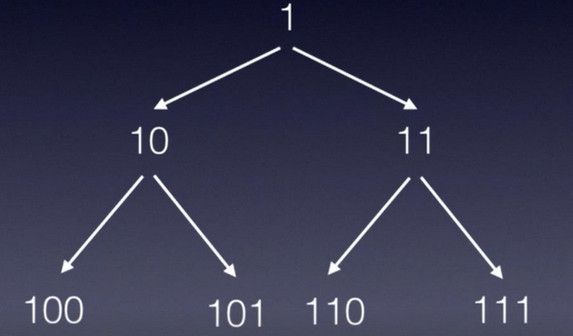
Find the Multiple
//2024-03-12 Find the Mutiple 自写
#include <iostream>
#include <cstdio>
#include <queue>
using namespace std;
void BFS(int n) {
queue<long long> myQueue;
myQueue.push(1);
while(!myQueue.empty()) {
long long current = myQueue.front();
myQueue.pop();
if(current % n == 0) {
cout << current << endl;
return;
}
myQueue.push(current * 10);
myQueue.push(current * 10 + 1);
}
}
int main()
{
int n;
while(cin >> n) {
if(n == 0)
break;
BFS(n);
}
return 0;
}
宽度优先搜索常被用来求解最优值问题,因为其搜索到的状态总是按照其某个关键字递增。因此,一旦问题中出现最少、最短、、最优等关键字,就要考虑是否是宽度优先搜索问题。
由于深度优先搜索并没有先入先出的特点,所以搜索到需要的状态时,该状态不再像是宽度优先搜索中的状态一样,具有某种最优的特性。因此,使用深度优先搜索策略时,常常是为了知道问题是否有解。
3.DFS
策略:优先处理最深的结点,可以发现先扩展的状态可能较后才处理,与栈的后入先出特性相符,但在实际操作中,往往使用递归的方式来实现DFS。
3.1 A Knight's Journey
像象棋一样,马这个棋字的行走规则是“日”字。
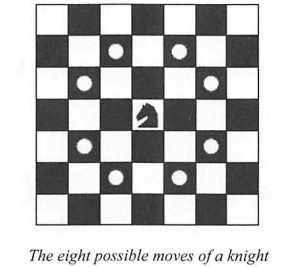
同样首先分析搜索问题的4个组成部分:
-
1、状态空间:当前游历到的点的坐标,以及总共走了多少格 (x, y, step)
-
2、状态转移:一共8种 (x-1, y-2, step+1)、(x+1, y-2, step+1)...
-
3、起始状态: (0, 0, 1) 如果存在解,一定是从A1开始搜索,使得游历的字典序最小
-
4、目标状态: (x, y, sizeof board) 在哪点终止不确定,但格子数确定
画出搜索树:

题目要求是找到一条路径能够遍历到棋盘的每一格,相当于要求搜索树的深度height与格子数量相同,并且注意要设置visit数组,之前已经访问过的格子不能再进行扩展或计入树高。
骑士的环球旅行
//2024-03-13 骑士的旅行
#include <iostream>
#include <cstdio>
#include <cstring>
using namespace std;
int direction[8][2] = {
{-1, -2}, {1, -2}, {-2, -1}, {2, -1}, {-2, 1}, {2, 1}, {-1, 2}, {1, 2}
};
const int MAXN = 30; //棋盘格数+5安全冗余
bool visit[MAXN][MAXN];
bool DFS(int x, int y, int step, string answer, int p, int q) {
if(step == p * q) {
cout << answer << endl << endl;
return true;
}
//步数没到棋盘尺寸,就要进行扩展,有8种扩展方式
for(int i = 0; i < 8; ++i) {
int nx = x + direction[i][0];
int ny = y + direction[i][1];
if(nx < 0 || nx >= p || ny < 0 || ny >= q || visit[nx][ny]) {
continue;
}
visit[nx][ny] = true;
char col = ny + 'A';
char row = nx + '1';
if(DFS(nx, ny, step + 1, answer + col + row, p, q)) {
return true;
}
visit[nx][ny] = false; //不再访问这个状态,这个状态下的所有扩展状态均无解
}
return false;
}
int main()
{
int n;
scanf("%d", &n);
int caseNumber = 0;
while(n--) {
int p, q;
cin >> p >> q;
memset(visit, false, sizeof(visit));
cout << "Scenario #" << ++caseNumber << ":" << endl;
visit[0][0] = true;
if(DFS(0, 0, 1, "A1", p, q)) {//压入初始状态进行处理
continue;
} else {
cout << "impossible" << endl << endl;
}
}
return 0;
}
3.2 Square
给出若干根长度不一的木棍,问它们能否拼成一个正方形,涉及搜索树减枝,这个例子先留个坑。
首先看搜索问题的4个部分:
-
1、状态空间: (sum, number) sum指当前已拼凑木棍的长度,第二个number,指已经拼凑成为正方形边长的个数
-
2、状态转移: (sum + stick[i], number),有可能发现状态变异-> (0, number + 1)
-
3、初始状态: (0, 0)
-
4、目标状态: (0, 4)
画出搜索树,由于扩展的状态数目由木棍数目决定,所以不定:
每往下搜索一层,就多用掉一根木根,所以可以判定木棍是否用完,以及最终拼凑出的边长个数是否等于4,所以应该用DFS搜索策略。

因为每个木棍只能使用一次,故要一个visit数组记录是否使用过这根木棍。
留个坑,DFS啊~






 浙公网安备 33010602011771号
浙公网安备 33010602011771号